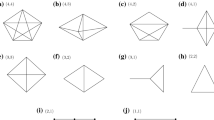Abstract
We study a new set of duality relations between weighted, combinatoric invariants of a graph G. The dualities arise from a non-linear transform \(\mathcal{B}\), acting on the weight function p. We define \(\mathcal{B}\) on a space of real-valued functions \(\mathcal{O}\) and investigate its properties. We show that three invariants (the weighted independence number, the weighted Lovász number, and the weighted fractional packing number) are fixed points of \(\mathcal{B}^2\), but the weighted Shannon capacity is not. We interpret these invariants in the study of quantum non-locality.
Similar content being viewed by others
References
Abramsky S, Brandenburger A. The sheaf-theoretic structure of non-locality and contextuality. New J Phys, 2011, 13: 113036
Acín A, Brunner N, Gisin N, et al. Device-independent security of quantum cryptography against collective attacks. Phys Rev Lett, 2007, 98: 230501
Acín A, Duan R, Roberson D E, et al. A new property of the Lovász number and duality relations between graph parameters. Discrete Appl Math, 2017, 216: 489–501
Acín A, Fritz T, Leverrier A, et al. A combinatorial approach to nonlocality and contextuality. Comm Math Phys, 2015, 334: 533–628
Anders J, Browne D E. Computational power of correlations. Phys Rev Lett, 2009, 102: 050502
Berge C. Graphs and Hypergraphs. Amsterdam: Elsevier, 1973
Bermejo-Vega J, Delfosse N, Browne D E, et al. Contextuality as a resource for models of quantum computation with qubits. Phys Rev Lett, 2017, 119: 120505
Brandão F G S L, Datta N. One-shot rates for entanglement manipulation under non-entangling maps. IEEE Trans Inform Theory, 2011, 57: 1754–1760
Brunner N, Cavalcanti D, Pironio S, et al. Bell nonlocality. Rev Mod Phys, 2014, 86: 419–478
Bu K F, Singh U, Fei S-M, et al. Maximum relative entropy of coherence: An operational coherence measure. Phys Rev Lett, 2017, 119: 150405
Buhrman H, Cleve R, Massar S, et al. Nonlocality and communication complexity. Rev Modern Phys, 2010, 82: 665–698
Cabello A, Severini S, Winter A. Graph-theoretic approach to quantum correlations. Phys Rev Lett, 2014, 112: 040401
Dantzig G B, Thapa M N. Linear Programming 2: Theory and Extensions. Berlin: Springer-Verlag, 2003
Datta N. Min- and max-relative entropies and a new entanglement monotone. IEEE Trans Inform Theory, 2009, 55: 2816–2826
Datta N. Max-relative entropy of entanglement, alias log robustness. Int J Quant Inform, 2009, 7: 475–491
Delfosse N, Guerin P A, Bian J, et al. Wigner function negativity and contextuality in quantum computation on rebits. Phys Rev X, 2015, 5: 021003
Fenchel W. On conjugate convex functions. Canad J Math, 1949, 1: 73–77
Howard M, Wallman J, Veitch V, et al. Contextuality supplies the magic for quantum computation. Nature, 2014, 510: 351–355
Imrich W, Klavzar S. Product Graphs: Structure and Recognition. New York: Wiley-Intersciene, 2000
Knuth D E. The sandwich theorem. Electron J Combin, 1994, 1: A1
Kochen S B, Specker E. The problem of hidden variables in quantum mechanics. J Math Mech, 1967, 17: 59–87
Koenig R, Renner R, Schaffner C. The operational meaning of min- and max-entropy. IEEE Trans Inform Theory, 2009, 55: 4337–4347
Lovász L. On the Shannon capacity of a graph. IEEE Trans Inform Theory, 1979, 25: 1–7
Raussendorf R. Contextuality in measurement-based quantum computation. Phys Rev A (3), 2013, 88: 022322
Shannon C E. The zero error capacity of a noisy channel. IRE Trans Inform Theory, 1956, 2: 8–19
Acknowledgements
This work was supported by the Templeton Religion Trust (Grant No. TRT 0159). The third author was supported by USA Army Research Office (ARO) (Grant No. W911NF1910302). The first author is grateful for the support of the Academic Award for Outstanding Doctoral Candidates from Zhejiang University. The authors thank Zhengwei Liu for his support, help, and comments. The second author thanks Liming Ge and Boqing Xue for discussion on related material.
Author information
Authors and Affiliations
Corresponding author
Rights and permissions
About this article
Cite this article
Bu, K., Gu, W. & Jaffe, A. Duality of graph invariants. Sci. China Math. 63, 1613–1626 (2020). https://doi.org/10.1007/s11425-018-9563-3
Received:
Accepted:
Published:
Issue Date:
DOI: https://doi.org/10.1007/s11425-018-9563-3



